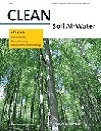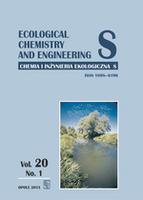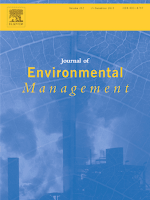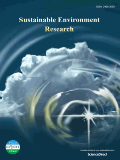
Environmental Engineering and Management Journal
Scope & Guideline
Pioneering research at the intersection of engineering and ecology.
Introduction
Aims and Scopes
- Environmental Remediation:
Research dedicated to the development and assessment of techniques for the removal or neutralization of pollutants from the environment, including studies on bioremediation and the use of adsorbents derived from agricultural waste. - Water and Wastewater Management:
Focus on innovative methods for treating water and wastewater, including electrocoagulation, constructed wetlands, and biological treatment processes, aimed at improving water quality and sustainability. - Sustainable Resource Management:
Exploration of sustainable practices in waste management, including recycling, waste-to-energy technologies, and the circular economy, with an emphasis on reducing environmental impacts. - Climate Change and Environmental Impact Assessment:
Studies assessing the impacts of climate change on environmental systems and the effectiveness of various mitigation strategies, including carbon emission reduction and resource efficiency. - Ecological Engineering and Management:
Research exploring the integration of ecological principles into engineering practices, such as habitat restoration, biodiversity conservation, and ecosystem service assessments. - Renewable Energy and Green Technologies:
Investigation of renewable energy sources and green technologies, focusing on their environmental benefits, efficiency, and integration into existing systems.
Trending and Emerging
- Microplastics and Emerging Contaminants:
Research on microplastics and other emerging contaminants has surged, reflecting growing concerns about their environmental and health impacts. - Digital Technologies in Environmental Management:
The integration of digital technologies, such as remote sensing, GIS, and machine learning, in environmental monitoring and management is gaining traction, emphasizing data-driven approaches. - Circular Economy Practices:
There is an increasing focus on circular economy practices, including waste valorization and sustainable resource management strategies that seek to minimize waste and maximize resource efficiency. - Climate Adaptation Strategies:
Research addressing climate adaptation and resilience strategies is becoming more prominent, highlighting the need for innovative solutions in response to climate change impacts. - Sustainable Urban Development:
Emerging studies on sustainable urban development practices, including green infrastructure and urban resilience, are trending, reflecting the importance of sustainable city planning.
Declining or Waning
- Heavy Metal Pollution Studies:
Research specifically targeting heavy metal pollution has decreased, suggesting a shift towards broader environmental issues like microplastics and organic pollutants. - Traditional Waste Disposal Methods:
There is a noticeable reduction in studies focusing on conventional waste disposal methods, as emphasis has shifted towards innovative recycling and resource recovery strategies. - Chemical Treatment Solutions:
Papers centered on chemical treatment methods for pollution control are becoming less frequent, as the journal increasingly favors biological and eco-friendly approaches. - Local Case Studies without Broader Implications:
While local case studies remain relevant, there is a declining trend in publications that do not connect to broader environmental management frameworks or global sustainability goals. - Agricultural Impact Studies on Soil Quality:
Research specifically examining the impacts of agriculture on soil quality is waning, possibly indicating a shift towards integrated studies that encompass environmental, social, and economic dimensions.
Similar Journals

Environmental Engineering Research
Transforming ideas into impactful environmental solutions.Environmental Engineering Research, published by the Korean Society of Environmental Engineers (KSEE), stands as a pivotal journal in the field of environmental engineering. With an ISSN of 1226-1025 and an E-ISSN of 2005-968X, this esteemed journal has shown remarkable growth since its inception, converging years from 2011 to 2024. The journal is recognized in the Scopus ranking system, holding a position of #46 out of 197 in the Environmental Science category, marking it in the 76th percentile—a testament to its impact and significance in the field. Furthermore, it enjoys a commendable Q2 ranking in Environmental Engineering for 2023. While the journal operates under a traditional access model, its commitment to disseminating vital research and innovative solutions for environmental challenges enhances its appeal to researchers, professionals, and students alike. The Environmental Engineering Research journal invites contributions that advance the understanding and application of engineering principles to environmental issues, providing a forum for scholars dedicated to fostering sustainability and environmental protection.

Clean Technologies and Environmental Policy
Innovating policies for a cleaner, healthier planet.Clean Technologies and Environmental Policy is a prestigious journal published by Springer, dedicated to advancing the field of environmental science through the lens of sustainable technology and policy-making. Since its inception in 2004, the journal has carved out a significant niche within the academic community, boasting an impressive impact factor reflective of its quality, as evidenced by its ranking in the Q1 and Q2 categories across various disciplines, including Environmental Engineering and Business, Management and Accounting. With a focus on innovative approaches to managing environmental challenges, the journal covers a wide array of topics from management strategies in environmental engineering to methodologies in policy development. This comprehensive scope positions it as an essential resource for researchers, professionals, and students seeking to contribute to the dialogue on sustainable development and environmental stewardship. Although it operates without Open Access, the journal ensures rigorous peer review and timely publication of high-quality research, facilitating the dissemination of knowledge necessary for informed decision-making in the ever-evolving field of environmental science.

CLEAN-Soil Air Water
Exploring the Intersection of Chemistry and Environmental StewardshipCLEAN-Soil Air Water, an esteemed journal published by Wiley, serves as a vital platform for disseminating research in the fields of environmental chemistry, pollution, and water science and technology. Operating under an Open Access model, it embraces the principles of knowledge sharing, making significant research findings readily accessible to a global audience. With an ISSN of 1863-0650 and an E-ISSN of 1863-0669, the journal has demonstrated its importance in the academic community, reflected in its Scopus rankings within the top quartiles of its categories. Established in 2007 and continuing through to 2024, CLEAN-Soil Air Water offers researchers, professionals, and students an opportunity to explore innovative studies that address pressing environmental challenges, facilitating an exchange of novel ideas and techniques essential for sustainable development. With a publication footprint in Germany and a growing international reputation, this journal is an invaluable resource for those dedicated to advancing the science and practices of environmental stewardship.

Ecological Chemistry and Engineering S-Chemia I Inzynieria Ekologiczna S
Advancing Ecological Solutions for a Sustainable FutureEcological Chemistry and Engineering S, a prominent journal in the field of Environmental Chemistry and Engineering, provides a platform for innovative research and critical discussions surrounding ecological solutions and sustainable practices. Published by SCIENDO, this peer-reviewed journal is accessible to researchers and professionals dedicated to advancing our understanding of ecological systems and sustainable engineering practices. With an ISSN of 1898-6196 and an E-ISSN of 2084-4549, the journal has established itself in the academic community, reflected by its Q3 ranking in both Environmental Chemistry and Environmental Engineering categories as of 2023. Covering significant advancements from 2008 to 2024, it serves as an essential resource in advancing knowledge and fostering collaborations within interdisciplinary fields. Despite not offering open access, the journal remains an invaluable resource for researchers and students aiming to contribute to ecological sustainability strategies worldwide.

Engenharia Sanitaria e Ambiental
Connecting innovation with global environmental challenges.Engenharia Sanitaria e Ambiental is a distinguished journal published by the Associação Brasileira de Engenharia Sanitária e Ambiental and has been an influential resource in the fields of sanitation and environmental engineering since its inception. With an Open Access format established in 2004, it ensures that invaluable research is freely accessible to a global audience, supporting the dissemination of knowledge and innovation. Based in Brazil, the journal addresses critical issues surrounding waste management and environmental sustainability, contributing significantly to the discourse in these areas. Although currently ranked in Q4 within its category as of 2023, it serves as a platform for emerging research and aims to elevate the standards of environmental science education and practice. Researchers, professionals, and students alike benefit from its commitment to enhancing the understanding of sanitary and environmental challenges, making it an essential resource for those striving to contribute to a healthier and more sustainable world.

Journal of Environmental Management
Advancing sustainable solutions for a better planet.The Journal of Environmental Management is a leading peer-reviewed journal dedicated to advancing knowledge and research in the fields of environmental science, management, and policy. Published by Academic Press Ltd - Elsevier Science Ltd, this esteemed journal has been pivotal since its inception in 1973, providing a platform for innovative research, critical reviews, and insightful discussions surrounding pressing environmental issues. With an impressive impact factor placing it in the Q1 category across multiple disciplines—including Environmental Engineering and Waste Management—it ensures that published works are highly regarded and widely disseminated. Furthermore, its Scopus rankings reflect its prominence, being in the top percentile within its categories, which highlights the journal's influence on shaping environmental policies and practices. While the journal does not currently offer Open Access, it remains a crucial resource for researchers, professionals, and students committed to fostering sustainable management solutions. By continually addressing emerging challenges in environmental management, the journal serves as an essential reference point for academics and policymakers alike.

International Journal of Environmental Science and Technology
Leading the charge in sustainable technology research.International Journal of Environmental Science and Technology, published by SPRINGER, stands as a premier platform for the dissemination of cutting-edge research in the fields of environmental science, technology, and engineering. With an impressive scope spanning from 2005 to 2024, this journal serves as a vital resource for academic and professional communities engaged in tackling pressing environmental challenges. It boasts a strong reputation, evidenced by its Q1 ranking in Agricultural and Biological Sciences and solid placements in Environmental Chemistry and Engineering. Researchers searching for high-impact studies will find the journal's contributions significant, as reflected in its rankings within Scopus: 34th percentile in Agricultural and Biological Sciences and notable standings in Environmental Engineering and Chemistry. Although the journal is not currently an Open Access resource, it maintains a commitment to academic rigor and innovation, making it indispensable for those devoted to advancing knowledge in environmental sustainability and technology.

Sustainable Environment Research
Empowering global change with cutting-edge environmental science.Sustainable Environment Research, an esteemed journal published by BMC, serves as a pivotal platform for disseminating innovative research in the fields of Environmental Engineering, Pollution, and Renewable Energy. Established in 2016 as an Open Access journal, it facilitates the widespread sharing of knowledge and advancements across the globe, reflecting its commitment to enhancing environmental sustainability. With an impressive Q1 ranking in multiple categories, including Water Science and Technology and Pollution, the journal is recognized for its significant impact, currently holding a rank of 31st in Environmental Science - Water Science and Technology. The journal actively invites researchers, professionals, and students to contribute to crucial discussions around sustainable practices and technologies, thus addressing worldwide environmental challenges. Based in Taiwan but accessible internationally, Sustainable Environment Research provides a valuable resource for those dedicated to advancing the science of sustainability.

CT&F-Ciencia Tecnologia y Futuro
Innovating solutions for tomorrow's challenges.CT&F-Ciencia Tecnologia y Futuro, a distinguished open-access journal published by ECOPETROL SA, serves as a vital platform for the dissemination of innovative research and advancements in the fields of chemical engineering, energy, fuel technology, and the broader disciplines within the geosciences. Established in 1996 and operating continuously until 2023, this bilingual journal aims to foster collaboration and knowledge exchange among researchers, professionals, and students in Colombia and beyond. With an increasing emphasis on sustainability and renewable energy, CT&F aligns with contemporary academic priorities and societal challenges. Although currently ranked in the Q4 category across multiple disciplines, the journal remains committed to enhancing its impact and accessibility, providing researchers with valuable insights and a significant forum to share their findings, all under the auspices of open-access since 2009. Explore a wealth of research as you contribute to the ongoing dialogue shaping the future of science and technology.

Environmental Science-Water Research & Technology
Innovating solutions for sustainable water management.Environmental Science-Water Research & Technology is a premier journal published by the Royal Society of Chemistry that focuses on the latest research and technological advancements in the field of water science and engineering. Since its inception in 2015, the journal has steadily gained recognition for its rigorous peer-review process and commitment to advancing our understanding of fresh, wastewater treatment, and sustainable water management. With a remarkable 2023 impact factor and consistently achieving Q1 status in both Environmental Engineering and Water Science and Technology categories, this journal ranks within the top percentile of its field, underscoring its pivotal role in fostering innovative solutions to global water challenges. Currently listed as Rank #26/261 in Water Science and Technology and Rank #34/197 in Environmental Engineering by Scopus, it provides an essential platform for researchers, professionals, and students alike. The journal embraces a broad spectrum of topics concerning water research, aiming to bridge the gap between scientific understanding and practical application.